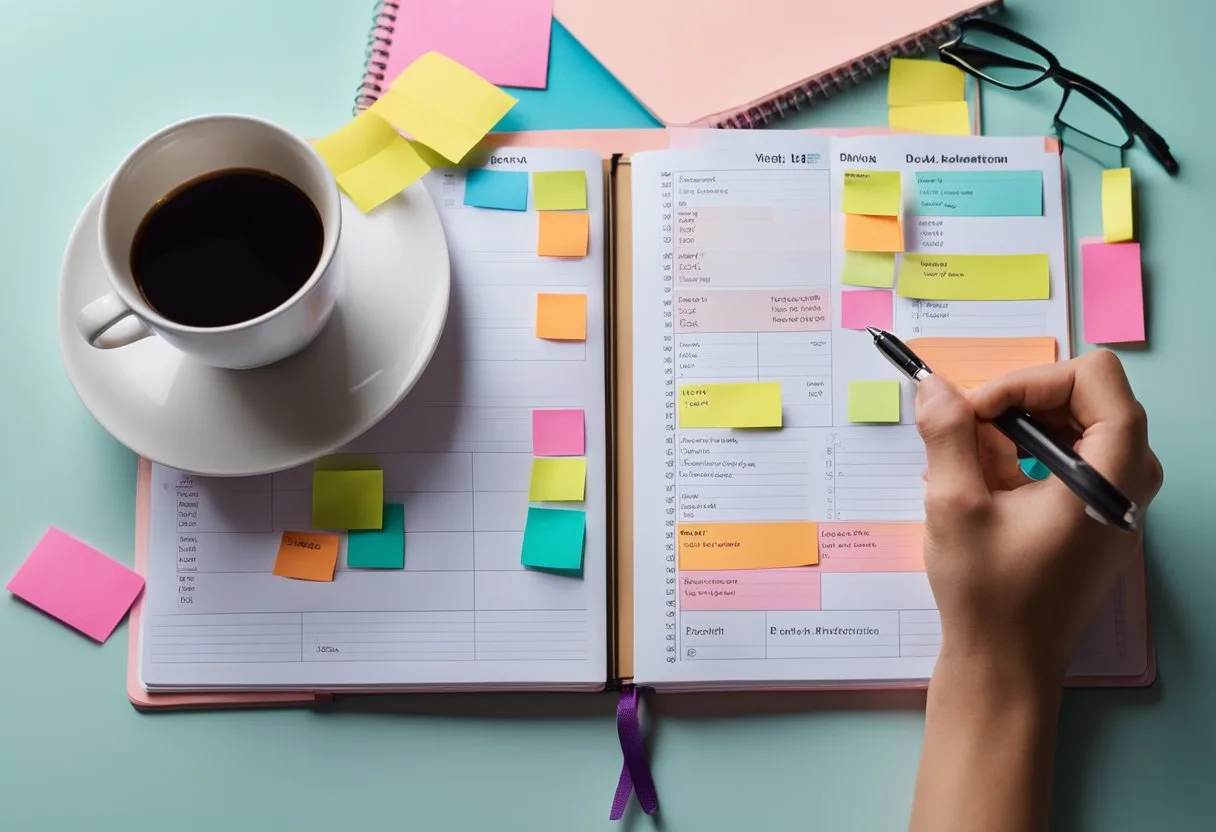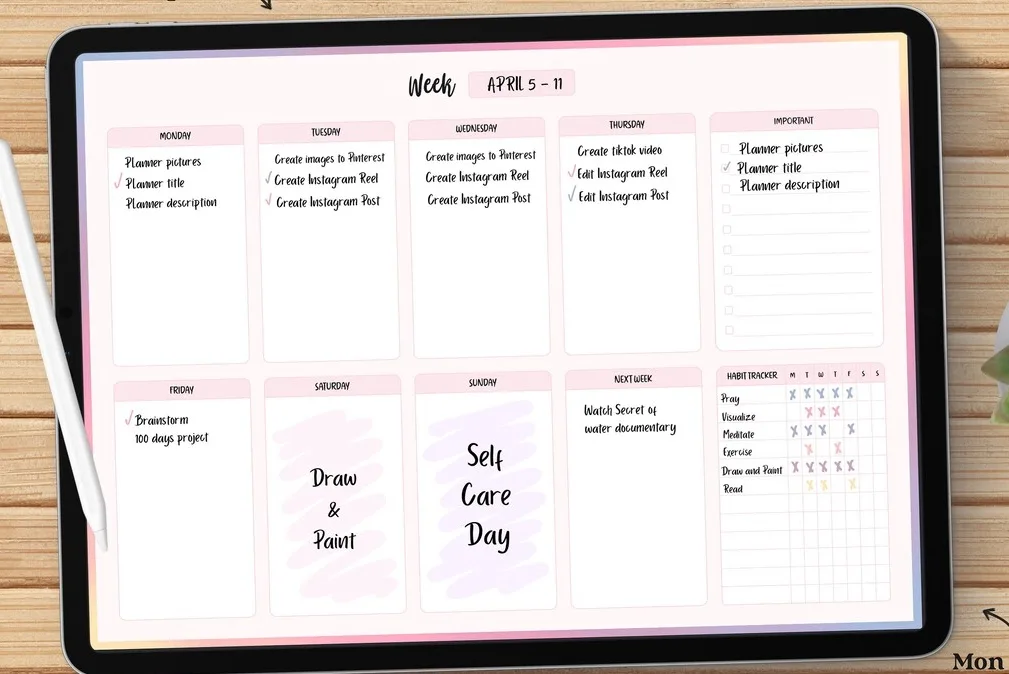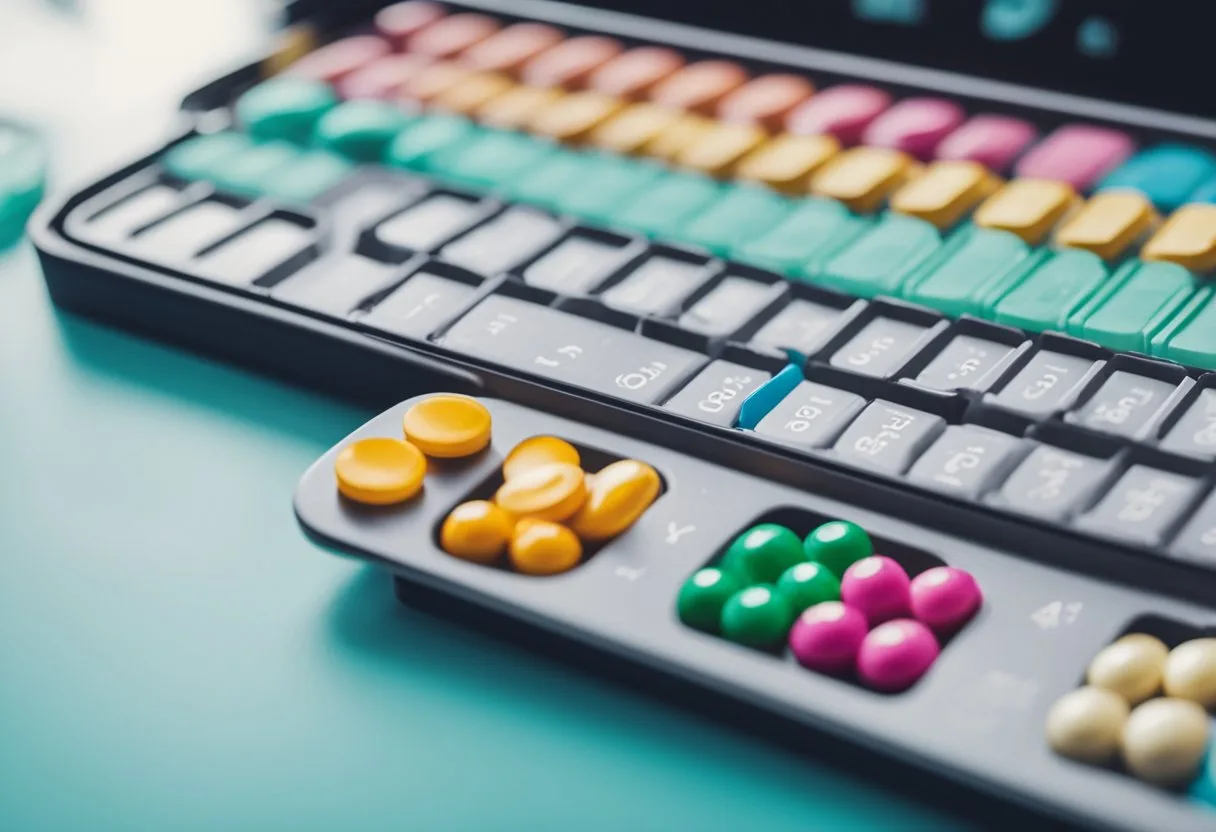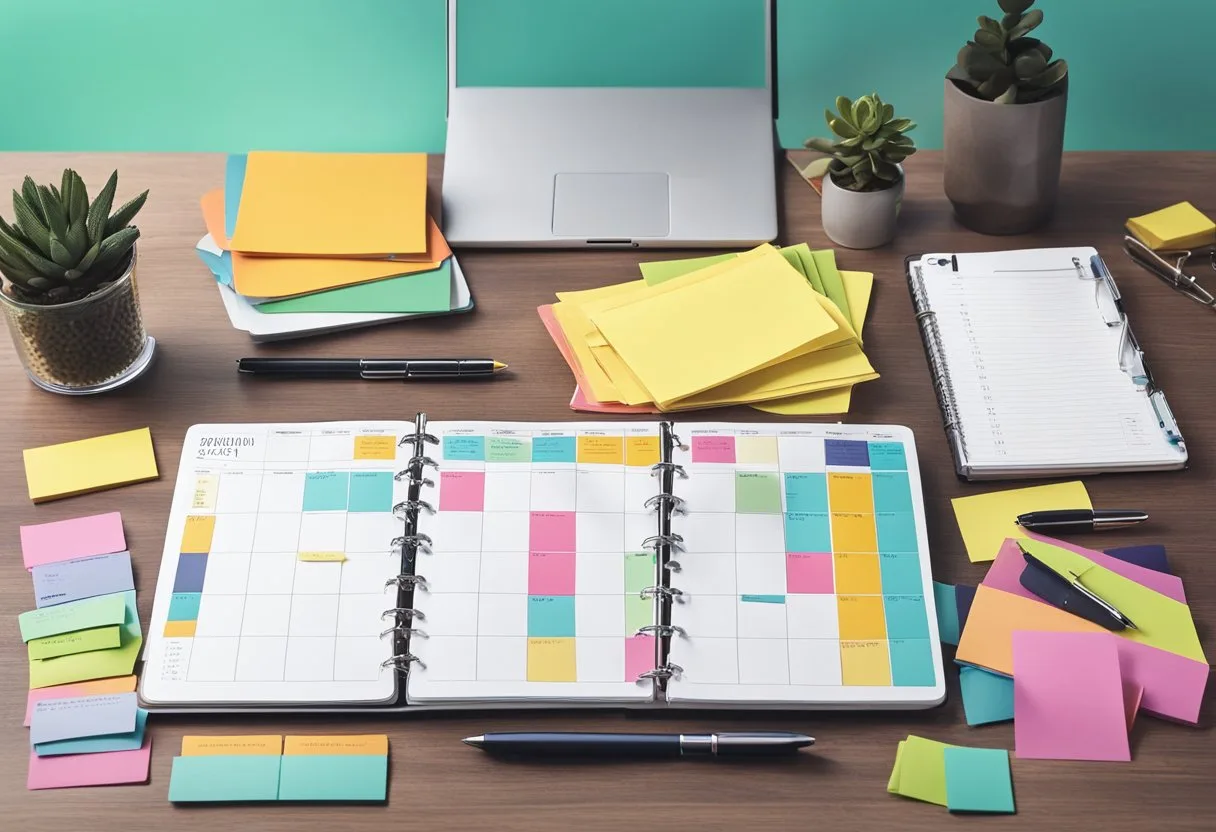Keeping a planner is a great way to stay organized and manage your time effectively. A planner can help you keep track of appointments, deadlines, and tasks, and can be a valuable tool for both personal and professional use. However, keeping a planner can be challenging if you don’t have the right strategies in place. In this blog post, I will share with you how to keep a planner and provide you with tips and tricks to help you stay organized.
One of the most important things to keep in mind when using a planner is to choose the right planner for your needs. There are many different types of planners available, from basic paper planners to digital apps, and it’s important to find one that fits your lifestyle and preferences. Some people prefer a planner with a daily or weekly layout, while others prefer a more flexible format that allows for more customization.
Choosing the Right Planner
Choosing the right planner is an important step in keeping yourself organized and efficient. There are two primary types of planners: digital and paper. Each has its own advantages and disadvantages, and the choice between them depends on personal preference.
Determining Planner Size and Layout
The size and layout of the planner are crucial factors to consider when choosing the right planner. The planner size should be chosen based on where it will be used primarily and what printable pages you may need to include. Planners come in a variety of sizes, including pocket, A5, and letter-sized planners.
The layout of the planner is also important. Common layouts include 2 pages per week, 2 pages per day, 1 page per day, and monthly. Within these layouts, there can be different formats, like hourly, horizontal, and vertical. The layout should be chosen based on the individual’s needs and preferences.
Paper Planner vs Digital Planner
Digital planners are becoming increasingly popular due to their convenience and accessibility. They can be accessed from anywhere and can be easily shared with others. Digital planners also offer features such as reminders and the ability to set recurring tasks.
Paper planners, on the other hand, offer a more tactile experience and can be customized to fit individual needs. They also allow for more creativity and personalization. However, paper planners require more effort to maintain and can be more difficult to share with others.
The choice between a paper planner and a digital planner depends on personal preference and individual needs. It is important to consider the advantages and disadvantages of each before making a decision.
Setting Up Your Planner
Keeping a planner is an excellent way to keep track of important dates, appointments, and goals. Setting up your planner correctly is essential to ensure that you get the most out of it. Here are some tips to help you set up your planner effectively.
Starting with Important Dates and Goals
Before you start filling in your planner, it’s essential to identify your important dates and goals. These could include birthdays, anniversaries, appointments, meetings, and deadlines. Write these down in your planner to ensure that they are not forgotten.
It is also essential to identify your goals for the year. These could be personal, professional, or academic. Write these down in your planner and break them down into smaller, achievable tasks. This will help you stay focused and motivated throughout the year.
Creating a Monthly Overview
Once you have identified your important dates and goals, create a monthly overview in your planner. This will allow you to see the entire month at a glance and plan accordingly. Use a table or a list to write down all the important events and tasks for the month.
Include any recurring events such as birthdays, anniversaries, and meetings. Add any new appointments or deadlines as they arise. Use bold or italic formatting to highlight any critical events or tasks.
Setting up your planner correctly is crucial to ensure that you get the most out of it. Start by identifying your important dates and goals, and then create a monthly overview to plan accordingly. With these tips, you’ll be on your way to staying organized and achieving your goals.
How to keep a planner
Here’s a step-by-step guide on how to keep a planner:
- Choose the Right Planner: Find a planner that suits your style and needs. Consider size, layout (daily, weekly, monthly), and whether you prefer a physical book or a digital app.
- Make It a Habit: Integrate your planner into your daily routine. Set a specific time each day to review and update it, such as in the morning or before bed.
- Start with Important Dates: Fill in birthdays, anniversaries, holidays, and any other significant dates. Include recurring events like weekly meetings or classes.
- Use Monthly Overviews: At the start of each month, outline your month at a glance. Add appointments, key deadlines, and events.
- Plan Your Weeks: Every week, sit down to transfer monthly items to your weekly view. Add detailed tasks and to-dos for each day.
- Daily Entries: Write down daily tasks each morning or the night before. Check off completed items and carry over unfinished tasks to the next day.
- Prioritize Tasks: Label or color-code tasks by priority. This helps you focus on what’s most important and manage your time effectively.
- Review Regularly: At the end of each day and week, review your progress. Reflect on what you’ve accomplished and what needs to be adjusted.
- Keep It Updated: As plans change, update your planner accordingly. This keeps your schedule accurate and helps you stay flexible.
- Add Personal Notes: Use your planner for more than just tasks. Jot down thoughts, ideas, and personal reflections to make it a comprehensive record of your life.
- Track Your Habits: If you’re working on building new habits, use your planner to track your consistency and progress.
- Customize Your System: Tailor your planner to your needs. Use stickers, color-coding, or different sections to make it work for you.
- Carry It with You: If you’re using a physical planner, take it wherever you go. If it’s digital, sync it across your devices for access anywhere.
- Declutter Periodically: Regularly clean out old entries and remove tasks that are no longer relevant to keep your planner organized and up-to-date.
- Reflect and Reset: At the end of each year, take time to reflect on your achievements and setbacks. Use this insight to set goals and reset your planner for the new year.
Daily and Weekly Planning
Keeping track of daily and weekly tasks can be challenging, especially when there are multiple appointments and deadlines to remember. By using a planner, individuals can organize their schedule and manage their time more efficiently.
Time Blocking for Productivity
One effective method for managing time is time blocking. This involves dividing the day into specific time slots and assigning tasks to each slot. By doing so, individuals can focus on one task at a time and avoid multitasking, which can lead to decreased productivity.
To implement time blocking, it is important to first identify the most important tasks that need to be completed. These tasks should be assigned to the time slots that align with peak productivity times. For example, if an individual is most productive in the morning, they should assign their most important tasks to that time slot.
Incorporating To-Do Lists and Tasks
To-do lists and tasks are a crucial component of daily and weekly planning. They provide a visual representation of what needs to be done and help individuals prioritize their tasks.
When using a planner, it is important to incorporate to-do lists and tasks into the schedule. This can be done by assigning specific tasks to each day or by creating a separate section in the planner for to-do lists.
To ensure that tasks are completed on time, it is important to set realistic deadlines and prioritize tasks based on their level of importance. Tasks that are urgent and important should be completed first, followed by tasks that are important but not urgent.
Incorporating time blocking and to-do lists into a daily and weekly planner can help individuals manage their time more efficiently and increase productivity. By prioritizing tasks and assigning them to specific time slots, individuals can ensure that they are making the most of their time and achieving their goals.
Enhancing Planner Functionality
Keeping a planner is a great way to stay organized and on top of your tasks. However, there are ways to enhance the functionality of your planner to make it even more effective. Here are some tips to help you get the most out of your planner.
Using Stickers and Color Coding
One way to make your planner more visually appealing and easy to navigate is by using stickers and color coding. Stickers can be used to mark important events or deadlines, while color coding can be used to categorize tasks and events by priority or type.
For example, you could use red stickers or highlighter to mark urgent tasks, and green stickers or highlighter to mark completed tasks. This can help you quickly identify what needs to be done and what has already been accomplished.
Tracking Habits and Exercise
Another way to enhance the functionality of your planner is by tracking your habits and exercise. This can help you stay motivated and accountable for your goals. You could use a habit tracker to keep track of daily habits such as drinking enough water, taking vitamins, or practicing mindfulness. You could also use a fitness tracker to record your exercise routine and progress. This can help you stay on track and make adjustments as needed.
Using stickers and color coding, as well as tracking habits and exercise, are great ways to enhance the functionality of your planner. By implementing these tips, you can make your planner more effective and enjoyable to use.
Maintaining Your Planner
Regular Reviews and Updates
To ensure that your planner stays up-to-date and organized, it is important to regularly review and update it. This means taking the time to go through your planner and make any necessary adjustments, such as adding new tasks or events, rescheduling existing ones, or removing completed items.
One effective way to do this is to set aside a specific time each week to review and update your planner. This could be a Sunday evening, for example, or the first thing you do on Monday morning. By making this a regular habit, you can stay on top of your schedule and avoid feeling overwhelmed by a backlog of tasks.
Staying Motivated and Organized
Staying motivated and organized is key to maintaining a successful planner. One way to do this is to prioritize your tasks and create a productivity plan. This means identifying the most important tasks and scheduling them first, so that you can focus on completing them before moving on to less urgent items.
Another important factor is to stay organized. This means using your planner’s daily planner pages effectively, and keeping them updated with all the relevant information. You may also find it helpful to use color-coding or other visual aids to make your planner more visually appealing and easier to navigate.
Frequently Asked Questions
What are the best strategies for using a planner for work productivity?
Using a planner for work productivity involves setting clear goals, allocating time for tasks, and prioritizing tasks based on their importance. It may also involve breaking down larger tasks into smaller, manageable parts, and scheduling them accordingly. One effective strategy is to use a planner to plan out your entire workday, including breaks and non-work-related tasks.
What tips can help beginners effectively use a planner?
For beginners, it is important to choose a planner that suits their needs and preferences. They should also start by setting realistic goals and breaking down larger tasks into smaller ones. Beginners should also get into the habit of regularly reviewing their planner and making adjustments as needed. Another tip is to use color coding or other visual aids to make the planner more visually appealing and easier to use.
How can someone with ADHD benefit from using a planner?
For someone with ADHD, using a planner can help them stay on track and manage their time more effectively. It can also help them break down larger tasks into smaller, more manageable parts, and prioritize tasks based on their importance. Using a planner can help someone with ADHD reduce stress and anxiety by providing a sense of structure and control.
What are the advantages of maintaining a weekly planner?
Maintaining a weekly planner can help someone stay organized, manage their time more effectively, and reduce stress and anxiety. It can also help someone stay on track with their goals and priorities, and ensure that they don’t forget important tasks or appointments. Using a weekly planner can help someone identify patterns in their schedule and make adjustments as needed to improve their overall productivity and well-being.
How can I ensure I remember to use my planner regularly?
To ensure that you remember to use your planner regularly, it can be helpful to schedule a specific time each day to review and update it. You can also set reminders or alarms on your phone or computer to prompt you to check your planner. Keeping your planner in a visible location and using it consistently can help make it a habit.
In what ways does keeping a planner contribute to overall organization?
Keeping a planner can contribute to overall organization by providing a centralized location for all important tasks, appointments, and deadlines. It can also help someone stay on track with their goals and priorities, and ensure that they don’t forget important tasks or appointments. Using a planner can help someone identify patterns in their schedule and make adjustments as needed to improve their overall productivity and well-being.




